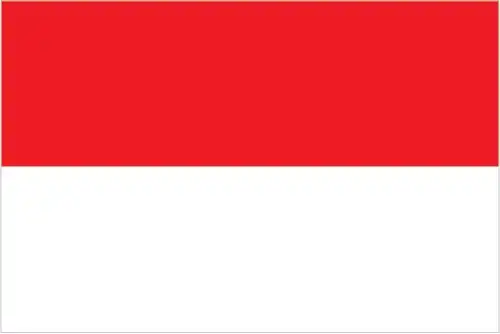Indonesia Flag
National Flag of Indonesia
Indonesia Flag Display

Quick Facts About Indonesia and Indonesia Flag
- Adopted:
- Aspect Ratio:
- 2:3
- Capital:
- Jakarta
- Population:
- Approximately 276 million (2023)
Flag Description
The Indonesian flag, known as *Sang Saka Merah Putih* (‘lofty red and white’), is a stark horizontal bicolour—red above, white below. Inspired by the banner of the 13th-century Majapahit Empire and ancient Austronesian symbolism, the flag reflects courage, purity, and national pride across a diverse archipelago.
Symbolism & Meaning of the Indonesia Flag
Red symbolizes courage, physical life, and human body; white stands for purity, spirit, and the soul. These colors are deeply rooted in local mythology, representing dualism—Mother Earth and Father Sky—in Austronesian tradition. They also evoke Indonesia’s enduring struggle for independence and reaffirm a collective will to build a just and noble nation.
Historical Background of the Indonesia Flag
Derived from ancient Majapahit banners and colonial-era student movements, the flag first appeared publicly in 1928 among nationalist youths and was reportedly hastily raised on 17 August 1945 when Sukarno proclaimed independence. The original hand-sewn 'Bendera Pusaka' flown that day remains a revered national relic, now preserved under guarded conditions. When sovereignty was recognized in 1949, the red and white flag was enshrined as Indonesia’s enduring emblem.
Design Elements of the Indonesia Flag
The design consists of two equal horizontal bands—red over white—in a 2:3 ratio. No emblem or motto appears on the national flag. For naval and military purposes, alternate designs like the nine-striped naval jack exist. The simplicity of the design emphasizes visibility, unity, and a timeless aesthetic rooted in heritage and national soul.
Usage & Protocol of the Indonesia Flag
Indonesian usage laws govern the flag’s display: it’s raised at sunrise and lowered at sunset, with special etiquette for Independence Day and memorial events. The revered original ‘Bendera Pusaka’ is flown only during official national ceremonies under guard. Desecration is punishable by law, and destroyed flags are to be respectfully burned. Variants exist for civil, government, naval, and presidential use, each with precise rules.
Frequently Asked Questions
What do the colors of the Indonesia Flag represent?
Red symbolizes courage, physical life, and human body; white stands for purity, spirit, and the soul. These colors are deeply rooted in local mythology, representing dualism—Mother Earth and Father Sky—in Austronesian tradition. They also evoke Indonesia’s enduring struggle for independence and reaffirm a collective will to build a just and noble nation.
When was the Indonesia Flag adopted?
The Indonesia flag was adopted on 17 August 1945, marking an important milestone in the country's development as an independent nation.
What is the aspect ratio of the Indonesia Flag?
The Indonesia flag has an aspect ratio of 2:3, which determines the proportional relationship between its width and height for official display purposes.